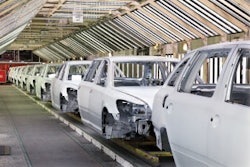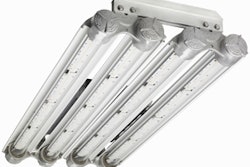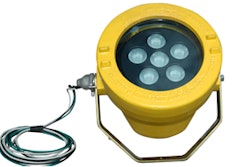Chem.Info’s monthly Dodging Disaster feature highlights a recent or historical safety disaster, drawing conclusions about how the incident could have been mitigated. In this installment, we look at the 2008 Goodyear heat exchanger rupture.
On June 11, 2008, one worker was killed, and six others were injured at a Goodyear Tire and Rubber Co. plant in Houston, TX, after a heat exchange rupture led to an ammonia release.
Overpressurization caused “a violent rupture of the exchanger, hurtling debris that struck and killed a Goodyear employee walking through the area. The heat exchanger contained pressurized anhydrous ammonia, a colorless, toxic chemical, used as a coolant in the production of synthetic rubber,” the U.S. Chemical Safety Board (CSB) states.
The following is a timeline of the incident, according to the CSB’s report:
June 10, 2008
- Operators close an isolation valve between the heat exchanger shell (ammonia cooling side) and a relief valve, to replace a burst rupture disk under the relief valve (which provides over-pressure protection).
- Maintenance workers replace the rupture disk, but the closed isolation valve is not reopened.
June 11, 2008
- In the morning, an operator closes a block valve, isolating the ammonia pressure control valve from the heat exchanger, and connects a steam line to the process line.
- The steam flows through the heat exchanger tubes, heats the liquid ammonia in the exchanger shell, and increases the pressure in the shell.
- The closed isolation and block valves prevent the increasing pressure from safely venting through either the pressure control valve, or the rupture disk and relief valve.
- At 7:30 a.m., the heat exchanger shell ruptures violently — throwing debris that strikes and kills an employee, and releasing ammonia, exposing five nearby workers to the chemical.
- The company evacuates the plant immediately, and medical responders transport the injured workers.
- The employee-tracking system fails to properly account for all workers, and as a result, management believes all workers safely evacuated.
- Management declares the incident over the morning of June 11, although debris blocks access to the area immediately surrounding the heat exchanger.
- Plant responders manage the cleanup while other areas of the facility resume operations.
- Several hours later, after plant operations have resumed, a supervisor assessing damage discovers the body of an employee located under debris.
After this incident, the CSB investigated the causes, and found that three key actions could have lessened the impacts of the disaster. These key issues are:
- Emergency response and accountability.
- Maintenance completion.
- Isolating pressure vessels.
If the above three issues would have been handled correctly, the incident itself could have been prevented, or at the very least, its impacts minimized.
CSB reports are important not only for the plant where the disaster occurred, but also for other facilities. These reports offer insight into best safety practices — insight that can hopefully help other plants avert disaster before it strikes.
Here are the takeaways from this case:
1. Emergency Response and Accountability
Even though the company thought that all of the employees had been safety evacuated, workers later found one victim buried in the rubble near the ruptured vessel. According to the CSB’s report, this error occurred due to lack of training and drills on worker headcounts. Therefore, the CSB urges that facilities conduct worker headcount drills, implementing their emergency response plans to see how effective they would be if an emergency were to occur.
According to the CSB, it is important to note that automated worker-tracking systems can malfunction, so plants should be equipped with a tested (and proven) manual worker-tracking system to substitute for the automated system if a malfunction occurs.
2. Maintenance Completion
On the day prior to the accident, maintenance work required closing several valves on the heat exchanger. CSB investigators found that “workers closed a valve that isolated the exchanger from a relief valve to replace a burst rupture disk located below the relief valve.” The real trouble came the next day, when at “about 7:30 a.m., an operator closed another valve — this one blocking a second automatic pressure control valve — to begin cleaning the process line with steam.” This operator was unaware that the isolation valve had been closed previously, and, “leaving no means of relieving excess pressure in the exchanger, pressure continued to increase until the heat exchanger exploded violently.”
The CSB urges that communication between maintenance and operations personnel is essential. “Good practice includes formal written turnover documents that inform maintenance personnel when a process is ready for maintenance and operations personnel when maintenance is completed, and the process can be safely restored to operation.” If the operator would have been aware that maintenance had closed the isolation valve, they would have been able to act accordingly.
3. Isolating Pressure Vessels
“Goodyear employees completely isolated an ammonia heat exchanger, including the over-pressure protection, while steaming a process line through the heat exchanger,” the report states. “Workers left the pressure relief line isolated for many hours following completion of the maintenance. In accordance with the ASME Boiler and Pressure Vessel Code, over-pressure protection shall be continuously provided on pressure vessels installed in process systems whenever there is a possibility that the vessel can be over-pressurized by any pressure source, including external mechanical pressurization, external heating, chemical reaction, and liquid-to vapor expansion.”
In addition, the CSB says that “workers should continuously monitor an isolated pressure relief system throughout the course of a repair and reopen blocked valves immediately after the work is completed.”
For more information, please visit www.csb.gov.






















